Thoroughly analyzing TS 10th Class Social Model Papers Set 9 with Solutions helps students identify their strengths and weaknesses.
TS 10th Class Social Model Paper Set 9 with Solutions
Time: 3 hours
Max. Marks:80
Instructions:
- Read the questions carefully, understand them, and answer.
- Write the answers for the questions in Part – A in the answer sheet.
- Attach the Map to Part – A answer sheet.
- Attach Part – B to Part A answer sheet.
- Part – A consists of I, II, and III Sections.
- Write the answers clearly duly following the instructions given for each section.
Part – A (Marks 60)
Section-I (6 x 2 = 12M)
1. Answer all questions.
2. Answer each question in 3 – 4 sentences.
3. Each question comes 2 marks.
Question 1.
Where did communal tensions rise in the years after the 1967 elections?
Answer:
- Ranchi (Bihar)
- Ahmedabad (Gujarat)
- Jalgaon (Maharashtra)
- Aligarh (Uttar Pradesh)
Question 2.
What is the impact on the environment by the excessive us pesticides and chemicals?
Answer:
- The excessive use of pesticides and chemical fertilisers exhibit a negative impact on the society.
- Environment cannot absorb harmful substances than a limit.
- When waste output exceeds the limit the sink function is limited, danger occurs to environment.
- It pressurizes the environment’s ability to provide different resources for production.
![]()
Question 3.
Why didn’t Gandhiji celebrate the first Independence Day?
Answer:
- Gandhiji moved amongst riot-hit people, in camps and hospitals, spreading the message of peace and brotherhood.
- He returned to Delhi on 9th September, 1947.
- This was not the freedom and Swaraj he had worked so hard to achieve.
- So, the Father of the Nation fasted and did not celebrate on the first Independence Day.
Question 4.
Give examples for different persons can have different developmental goals.
Answer:
- Landless rural labour: More days of work and better wages. Local school is able to provide quality education.
- Urban unemployed youth: A gainful employment throughout the year.
Question 5.
Why are the Himalayas important to India?
Answer:
Importance of Himalayas (Or) The Himalayas are important due to the following reasons:
- Himalayas influence the climate in various ways.
- They act as barriers protecting the great plains of India from cold winds of Central Asia during severe winter.
- They are the reasons for summer rains and monsoon type of climate in regions that are beyond the Western Ghats of India. In its absence, this region would have remained drier.
- The Himalayan Rivers make the plains fertile with their perennial flow.
Question 6.
What are the modern agricultural methods?
Answer:
Use of high-yielding variety of seeds, use of fertilisers and chemical pesticides, used water of borewells, use of machines etc. are all the modern methods followed in agricultural production.
Section – II (6 x 3 = 18 M)
1. Answer all questions.
2. Answer each question in 5 – 6 sentences.
3. Each question cames 3 marks.
Question 7.
What arguments were put forward by people who wanted the two regions to be united?
Answer:
The arguments were put forward by people that the two regions to be united were:
- Hyderabad had become a hub of development.
- The city had become India’s calling card for both the success of economic reforms.
- Many people from different parts had invested in properties in Hyderabad and large number of them had immigrated to Hyderabad in search of employment and education.
- The farmers of coastal areas were worried about getting irrigated water in the canals.
- If the new state was formed then there is no regular electric supply.
- Many of them also argued that it will be unfortunate if a state united by Telugu language was demerged to form two states.
Question 8.
“Globalisation by connecting countries results in greater competition among producers.” Justify the statement.
Answer:
- Globalisation is a major change that occurred across the globe in the late 20th century. This has political, cultural as well as economic dimensions.
- An MNC does different operations related to its business at different locations across the globe.
- An MNC is able to take advantage of cost benefit and also of easier access to important markets.
- There is a greater choice before the consumers who now improved quality and lower prices for several productions.
- Competition held between local producers and foreign companies.
Question 9.
Observe the graph and answer the following questions.
i) What does the above graph indicate?
ii) Which country has the highest armament stock during 1985?
iii) The nuclear stockpiles of which country did not change between 1995 – 2005?
iv) After which year the nuclear stockpiles of Russia exceeded America?
v) How much were the stockpiles of Russia and America during 1965?
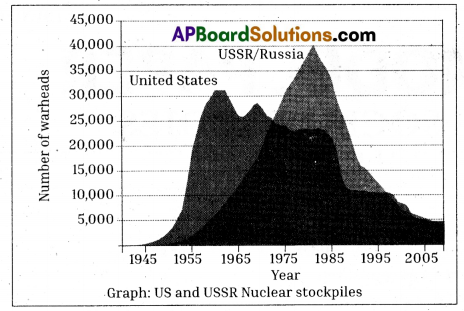
Answer:
i) The above graph indicates the nuclear stockpiles of the US and the USSR.
ii) USSR (Russia).
iii) America (USA).
iv After 1975, the nuclear stockpiles of Russia exceeded America.
v) The stockpiles of Russia and America during 1965 were 5000 and 30,000 respectively.
![]()
Question 10.
Do you think ‘Single Party Democracy’ would have been alternative to multiparty democracy?
Answer:
- I don’t think single-party democracy would have been a better alternative to multiparty democracy.
- Single party keeps on winning and may take decisions which are arbitrary and not compliance with Constitution.
- They may become authoritarian and overpower the democracy system itself.
- There may be a greater threat for civil liberties and freedoms in single-party democracies.
Question 11.
Read the following passage and answer the questions that follow.
Assume for the moment that there is no migration. In order to calculate these increases we examine two rates. (1) Birth rate is the number of live births per thousand persons in a year. In 1992, the birth rate in India was 29. This means that for every 1000 people living in the country during that year 29 live births took place. (2) Death rate is the number of deaths per thousand persons in a year. In the year 1992, for every 1000 persons living at that time, 10 people died during the year. Therefore 19 people for every 1000, was the addition during the year. This number can be expressed as a percentage, i.e. 1.9%. Hence we say that the population growth rate was 1.9% for the year 1992.
1. What was the population growth rate in 1992?
2. What was death rates?
3. What was the death rate in 1992?
4. What is birth rate?
5. What was the birth rate in 1992 in India?
Answer:
1. The population growth rate was 1.9% in 1992.
2. Death rate is the number of deaths per thousand persons in a year.
3. It w,s 10 per thousand.
4. Birth rate is the number of live births per thousand persons in a year.
5. It was 29.
Question 12.
Though India is one country, we find different climate conditions in North India comparing to South India. Why?
Answer:
- Climate conditions especially temperature is mostly influenced by latitudes.
- Though India is a single country, its northern part lies in Temperate zone, i.e., from Topic of Cancer to Arctic zone.
- So, it is away from the equator, the temperatures are less.
- But, the southern part of India lies in Tropical zone, i.e., from the Equator to Tropic of Cancer.
- It has maximum temperatures because of its nearness to the equator.
Section – III (6 x 5 = 30M)
1. Answer all questions.
2. There Is an internal choice for each question.
3. Answer each question in 8-10 sentences.
4. Each question carries 5 marks.
Question 13.
Observe the given table and answer the question that follows.
Crop Production (Kilograms per Hectare)
| Crop | 1950-1951 | 2000-2001 |
| Paddy | 668 | 1901 |
| Wheat | 655 | 2708 |
| Pulses | 441 | 544 |
| Oil seeds | 481 | 810 |
| Cotton | 88 | 190 |
| Jute | 1043 | 2026 |
Write an analysis on the yielding trends of different crops.
(OR)
“Meira Paibi literally can be translated as ‘torch bearers This movement was to prevent public disorder due to alcohol abuse in the late 1970, but soon it became a movement of human rights against armed forces. The activists are not politically motivated, they are ordinary women who take on responsibility for the safety and well-being of community.”
Write a comment on the struggle of ordinary women in Mema Paibi movement.
Answer:
In order to increase the per hectare yield crop, necessary inputs have to be provided injudious manner. One way is to expand irrigation but use water in manner so that this vital resource is shared and made available to all. Planting drought – resistant crops as per local conditions, water harvesting and crop rotation are therefore used to raise production on a given piece of land.
Some scientists and people, working in the field of agriculture report that the way rice and wheat are cultivated in India by intensive and unscientific application of chemical fertilisers and insecticides have led to continuous but unsustainable increase in the yield levels. In fact, these methods have led to soil degradation and depletion of groundwater resources. If this continues, we may soon come to a situation that yields start falling rather than going up.
(OR)
- Meira Paibi movement was led by ordinary women of Manipur to prevent the public disorder due to alcohol abuse during 1970s.
- Women of every ward or village participated in daily patrolling bearing torches, sit in vigils against threats.
- Later with the introduction of AESPA, the human rights of many families got disturbed.
- Gradually, women started movement against AFSPA and demanded to withdraw the Act.
- The efforts of women were such powerful that even elections were boycotted, rallies, relay hunger strikes were continued in society.
- Irom Sharmila, has been on hunger strike since 16 years under house arrest.
She ended the fast on 9th August, 2016, after 16 long years of fasting. Though the demands of the movement are not addressed completely, Supreme Court showed positive response to look into possibilities. We should admire and appreciate the efforts of women of Meira Paibi movement.
![]()
Question 14.
Observe the following graph and analyse it.
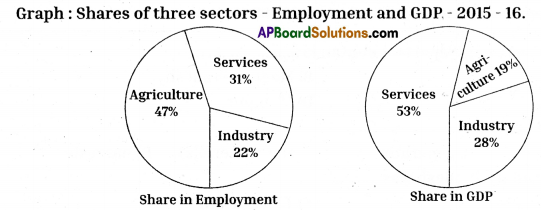
(OR)
What are the steps you suggest to turn your village into a model village like Hiware Bazar?
Answer:
The given pie – charts explain about the share of different sectors in employment and GDP i.e., Gross Domestic Product in the year 2015 -16.
- The share of Agriculture in employment is 47% but,its share in GDP is only 19%.
- The share of Industry in employment is 22% but its share in GDP is 28%.
- The share of employment in services is 31% whereas its share in GDP is 53%.
Reasons for this are:
- Decline in agriculture (Problems of seeds, rainfall, MSP, Powercut, water, etc).
- Increase of Privatisation.
- IT increased.
- Mass production of goods by factories.
- High payments for workers in service sectors.
(OR)
Our village is also in the rainfed region. We also face drought situations in summer. I wish to see our village as a model village like Hiware Bazar.
Steps I suggest:
- The soil and water conservation works to be implemented on common lands and on private grasslands of our village.’
- Continuous Contour Trenches (CCTs) are to be dug on the hill slopes to arrest the erosion of soil.
- In these trenches, water should be harvested and growth of grass is to be encouraged.
- Check dams, percolation tanks, loose boulder structures etc., should be constructed.
- Plantations on forest lands and roadsides are to be taken up.
- Tree felling and open grazing should be banned.
- Imposing some control over landowners on the usage of groundwater.
- Growing the seeds which can withstand droughts.
- Implementing co-operative agriculture.
- Digging Inkudu Guntalu in every house and thereby increasing the level of groundwater.
Question 15.
How can you say the formation of power blocks as a cause for world wars?
(OR)
What are the challenges faced by the independent Nigerian nation? In what ways is it similar or different from the challenges faced by independent India?
(Or)
Write about the national movements of India and Nigeria. What changes do you find in both these movements.
Answer:
- The world during late 19th century was divided into nation-states.
- They were grouped into power blocks and degenerated into war camps.
- The process of nation formation accelerated the scramble among iñdustrialised nations for control over the world.
- All nation-states wanted to have greater say in world diplomacy and their armies to back up national interests.
- Two main blocks emerged were the Central Powers and the Allies.
- Even enemies of the past like Austria and Italy or Britain and France formed the part of a same block.
- Similar blocks continued till Second World War – the axis powers led by Germany and the allies led by Britain, the U.S.A., and the U.S.S.R.
- Thus the formation of these blocks was a reckonable cause for world wars.
(OR)
a) Challenges faced by the independent Nigeria:
Nigeria became independent on 1st October, 1963. Unfortunately, ajust and democratic balance could not be worked out and soon Nigeria slipped into civil war and military rule which largely reinforced the domination of the north. Attempts were made repeatedly to bring in civilian and democratic governments but these failed again and again. Corruption and suppression of human rights went hand in hand with collaboration between the military regime and multinational oil corporations which funded the corrupt rulers. After a long haul of military dictatorship, Nigerians elected a democratic government in 1999. It remains to be seen how it faces the challenges of building a democratic Nigeria.
b) In many ways it is different from the challenges faced by independent India except corruption.
India faced the following challenges:
- Overpopulation
- Illiteracy
- Lack of technical knowledge
- Low utilization of natural resources, etc.
But the government is stable in India. The coordination between the government and the military is also ideal.
Question 16.
Have you ever observed any malpractices in the elections of your area? Which rule of Code of Conduct was violated? Share in Employment
(OR)
Observe the following graph and analyse it.
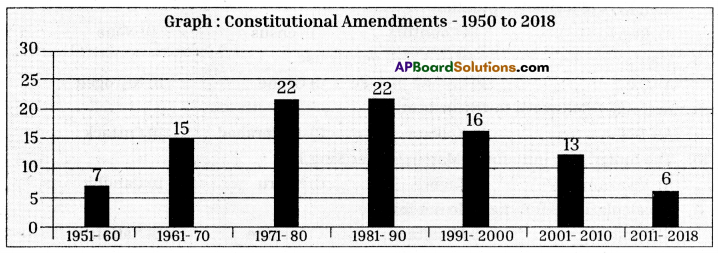
Answer:
In general elections or by-elections, the Election Commission conducts elections based on free and fair manner.
- Every political party that try to win in elections and form the government.
- In this way few political parties and contested candidates could have participated in malpractices during the time of elections.
- In some areas contested candidates distributed money and other materials for sure of their victory.
- Some parties having connections with criminals.
- During the election time parties requested to voters based on money, caste, community, and other.
- In some political parties committed with personal comments on other parties members.
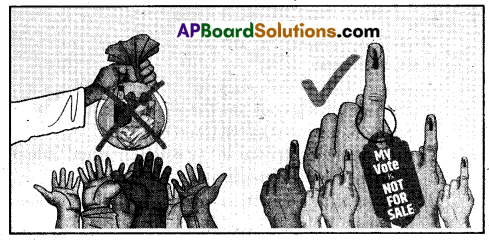
Which rule of code of conduct was violated.
- No voter shall be used to caste his/her vote in other’s identity.
- No personal comments shall be made.
- There should be no campaigning after or before the permitted hours.
- Vote requesting based on a caste or religion.
Above the code of conduct, rules are mostly violated in some constituencies.
(OR)
- This graph is about the Constitutional Amendments made since 1950 to 2018.
- Least number of amendments are made in 2011-2018.
- Number of total constitutional amendments done between l951-2018 are 101.
- Highest number of amendments are made during the decades 1971 – 80 and 1981-90.
- Equal number of amendments are made during the decades 1971-80 and 1981 – 90.
Question 17.
Feel that you are living in urban area. Write a letter to the Municipal Commissioner complaining about the urbanization problems arising due to migration and request to take necessary steps.
(OR)
“The Environment is crucially important for the lives and livelihoods of the localcommuni ties and the lifestyles of local communities are harmonious with The Environment. Explain.
Answer:
Sainagar Colony,
Warangal,
4th August, 2019.
To
The Commissioner,
Warangal Municipal Corporation,
Warangal.
Respected Sir,
I am Rama Rao, the resident (H. No ) of Srinagar Colony. I would like to bring a few lines to your notice about the urbanization problems in our locality for your kind consideration and necessary action. In our locality the migrant number is increasing. They are corning to city because of their needs and problems but it leads to new problems here. Water supply, sewage and other waste disposal, transportation and pollution problems are arising. There are plastic covers on the roads everywhere. Many animals on the roads eat those covers and die. As the garbage is increasing and it is not properly cleaned, unbearable stench is spread. There may be a scope for different diseases. I request you to increase the number of workers and take necessary action to make city clean so as to maintain good health in our locality.
Yours faithfully,
Rama Rao
Srinagar Colony
Address on the envelope:
To
The Commissioner,
WMC, Warangal.
(OR)
- The lives, livelihoods and the lifestyles of local communities are harmonious with the environment.
- Environment refers to all the conditions and influences surroundings and affects our existence and development.
- Tribal people’s conditions and surroundings influence the life, livelihood and lifestyles of Adivasis.
- In the same way, rural and urban conditions and surroundings affect the lifestyles.
- Climate, weather, soils, availability of water affect our lifestyle.
- The local communities which are harmonious with environment generally don’t prefer new environment.
![]()
Question 18.
1) River Godavari
2) Calcutta
3) Tamil Nadu
4) Vindhya mountains
5) Kanyakumari
(OR)
1) U.S.A.
2) Japan
3) Mediterranean sea
4) Egypt
5) Pacific Ocean
Answer:
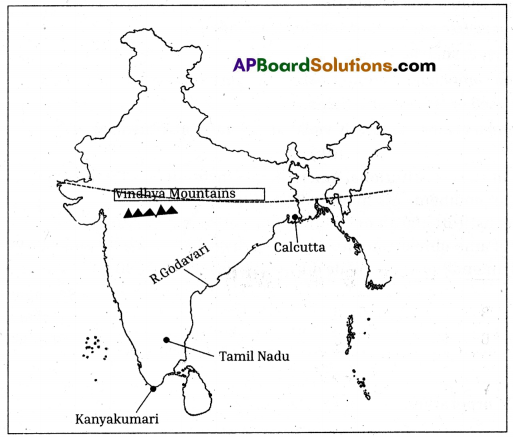
(or)
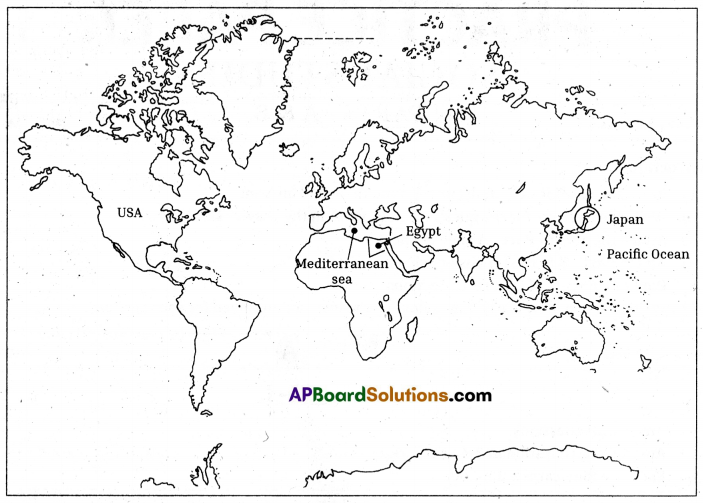
Part – B (Marks 20)
Instructions:
- Answer all questions.
- Choose the correct option from the given four Options and write the letter (A to B or C or D) in CAPITAL LETTER in the brackets.
- Each question carries 1 mark.
- Write the answers in the question paper itself.
- Marks are not given to corrected, dismissed or erased answers.
Question 1.
The Indian state between Nepal and Bhutan is …………… . ( )
A) Uttar Pradesh
B) Madhya Pradesh
C) Sikkim
D) Manipur
Answer:
C) Sikkim
Question 2.
Identify the odd one ………………….. . ( )
A) Plough
B) generator
C) raw materials
D) harvester
Answer:
C) raw materials
Question 3.
The first CM of Andhra Pradesh was ………………….. . ( )
A) B. Ramakrishna Rao
B) T. Prakasam
C) P. Sriramulu
D) None of the above
Answer:
B) T. Prakasam
Question 4.
Globalisation has created new opportunities of ………………….. .( )
A) Employment
B) Emerging multinational companies
C) Providing services
D) All the above
Answer:
D) All the above
![]()
Question 5.
Sri Lanka got its freedom in ( )
A) 1946
B) 1948
C) 1956
D) 1947
Answer:
B) 1948
Question 6.
Farmers of ……………….. states agitated under the leadership of Mahindra Singh Tikait. ( )
A) U.P and Bihar.
B) Bihar and Haryana.
C) Haryana and Madhya Pradesh.
D) U.P and Haryana.
Answer:
D) U.P and Haryana.
Question 7.
A ……………… is the procedure of systematically acquiring and recording information about the members of a given population ( )
A) Registration
B) Counting
C) Census
D) None
Answer:
C) Census
Question 8.
Plants use this to make proteins that people use ( )
A) Oxygen
B) Carbon dioxide
C) Ozone
D) Nitrogen
Answer:
D) Nitrogen
Question 9.
National Institute of Nutrition is at ( )
A) Delhi
B) Kolkata
C) Hyderabad
D) Cuttack
Answer:
C) Hyderabad
Question 10.
The Indian who influenced Martin Luther King Jr. . ( )
A) Vivekananda
B) Tagore
C) Nehru
D) Gandhi
Answer:
D) Gandhi
Question 11.
In calculating G.D.P, these do not involve ( )
A) Production
B) Monetary
C) Income
D) Nation
Answer:
D) Nation
Question 12.
The ……………………… rivers belong to the three principal systems. ( )
A) Peninsular
B) Himalayan
C) Western
D) Eastern
Answer:
B) Himalayan
Question 13.
Peace organisation setup after World War — I was ‘( )
A) United Nations
B) League of Nations
C) United States
D) United Arab Emirates
Answer:
B) League of Nations
Question 14.
…………………… invaded China in 1937. ( )
A) Japanese
B) Americans
C) Russians
D) None
Answer:
A) Japanese
![]()
Question 15.
How many Lok Sabha constituencies are in India? ( )
A) 542
B) 543
C) 544
D) 250
Answer:
B) 543
Question 16.
The American form of government is called the ……………. system. ( )
A) Parliamentary
B) Dictatorial
C) Presidential
D) None
Answer:
C) Presidential
Question 17.
The following is not an International Airport …………………. . ( )
A) Bengaluru
B) Delhi
C) Hyderabad
D) Ahmedabad
Answer:
D) Ahmedabad
Question 18.
The Narmada Valley Development Project is one of the largest In the world. ( )
A) Thermal electric project
B) Hydroelectric project
C) Atomic project
D) None
Answer:
B) Hydroelectric project
Question 19.
………………….. recruited the prisoners of war In his army which he called the Indian National Army. ( )
A) Mahatma Gandhi
B) Vallabhai Patel
C) Bhagat.Singh
D) S.C. Bose
Answer:
D) S.C. Bose
Question 20.
Which of the following is a developed country? ( )
A) Britain
B) India
C) China
D) Pakistan
Answer:
A) Britain